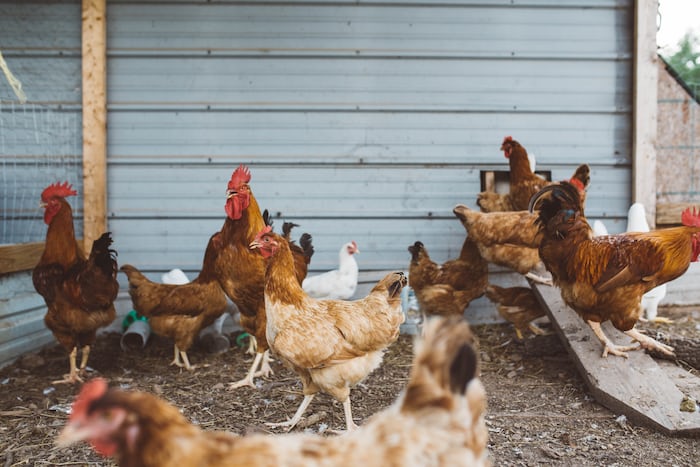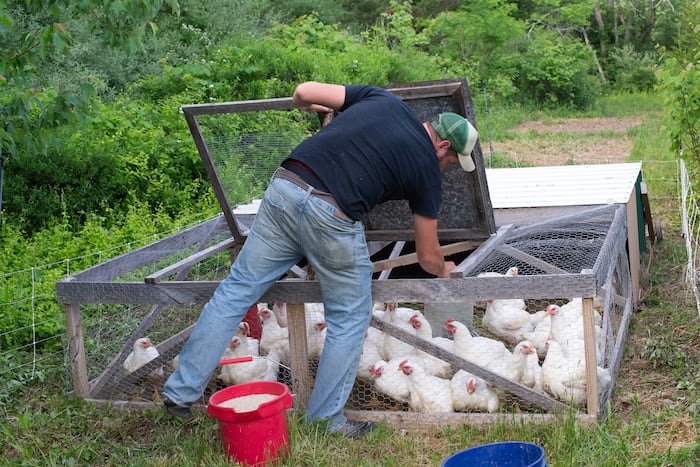What should be inside a chicken coop? This is one of the questions that is most frequently asked. Whether you're a seasoned chicken keeper or just starting your flock, one thing's for sure: a well-designed chicken coop is essential for the health, happiness, and productivity of your feathered friends.
Not only does a cozy coop provide a safe haven for your chickens, but it also ensures they lay delicious eggs consistently. So, if you want to create a home that your hens will cluck about with delight, you've come to the right place!
That's in this extensive blog post of the Poultry Farm Guide, we'll explore everything you need to know about chicken coops, from what they are and what they should look like inside, to building a door, determining the right size for your flock, and framing a chicken coop like a pro. So, without further ado, let's spread our wings and dive into the world of poultry housing!
People Also Read: Can Chicken Eat Cantaloupe? A Complete Guide for Chicken Owners

What is a Chicken Coop?
A chicken coop is a specialized structure designed to provide shelter and protection for chickens. It serves as a safe and secure living space where your feathered friends can sleep, lay eggs, and roost. Coops come in various shapes and sizes, depending on the number of chickens you have and the space available in your backyard.
While some coops are stationary, others are portable, allowing you to move them around your yard for fresh grazing areas. Additionally, well-ventilated chicken coops contribute to the overall health of your flock by preventing the buildup of harmful gases and excessive moisture.
What Does the Inside of a Chicken Coop Look Like?
Now that we understand what a chicken coop is, let's take a sneak peek into its interior. A well-organized coop ensures a comfortable and happy environment for your hens. Here are some essential features and elements that should be inside a chicken coop:
1. Nesting Boxes: Nesting boxes are cozy little compartments where your hens will lay their eggs. These boxes should be designed to mimic the feeling of a hidden nest, encouraging your chickens to lay eggs in a private and stress-free environment. A good rule of thumb is to have one nesting box for every three to four hens.
2. Roosting Bars: Chickens love to roost, which means they enjoy perching on elevated bars while sleeping. Roosting bars should be placed higher than the nesting boxes to prevent chickens from sleeping in the nests. Allow about 8-10 inches of roosting space per bird, and ensure the bars are comfortable for their feet.
3. Bedding Material: The coop floor should be covered with a layer of bedding material to absorb moisture, control odors, and provide a soft surface for your hens. Common bedding materials include straw, wood shavings, or pine pellets. Regularly clean and replace the bedding to maintain a clean and hygienic environment.
4. Ventilation: Proper ventilation is crucial to keep fresh air circulating inside the coop and prevent the buildup of harmful ammonia fumes. Install vents or windows that can be opened or closed as needed to regulate temperature and humidity levels.
5. Food and Water Stations: Ensure your chickens have easy access to fresh food and water at all times. Place their food and water stations off the ground to prevent contamination from droppings and bedding.
6. Lighting: Adequate lighting plays a vital role in encouraging hens to lay eggs consistently. Consider installing a timer to regulate the coop's lighting and maintain a consistent egg-laying schedule.
7. Egg Collection Door: A small door or hatch on the outside of the coop allows you to collect eggs without entering the main coop area, which minimizes disturbances to your hens and keeps them calm.
8.Perches or Ladders: If your coop has multiple levels or platforms, consider adding perches or ladders to help chickens navigate and explore their living space. Chickens enjoy roosting on different levels and it provides mental stimulation.
People Also Read: What Should Be Inside Your Chicken Coop? Essential Elements for a Functional and Productive Coop

How to Build a Door on a Chicken Coop (In Six Steps)
A door is a vital component of a chicken coop, as it not only allows access for you to care for your flock but also ensures their safety from predators. Building a door for your coop can be a straightforward process if you follow these simple steps:
Step 1: Measure the opening - Determine the dimensions of the door based on the size of your coop's entrance.
Step 2: Choose the material - Opt for sturdy materials such as plywood or lumber to construct the door. Make sure it can withstand various weather conditions.
Step 3: Cut the pieces - Cut the pieces for the door frame and panels using a saw, ensuring they fit together securely.
Step 4: Assemble the door - Nail or screw the pieces together to form the door frame. Attach the panels to the frame, leaving small gaps for ventilation.
Step 5: Add hinges - Attach heavy-duty hinges to the door frame and the coop entrance, allowing the door to swing open and close easily.
Step 6: Install a latch - Attach a latch or lock to keep the door securely closed when needed.
People Also Read: Maximizing Profits: The Ultimate Guide to Broiler Weight Management
.webp)
How Big of a Chicken Coop for 10 Chickens?
The size of your chicken coop is directly related to the number of chickens you plan to keep. For 10 chickens, you'll need a coop with ample space to ensure their well-being and happiness. A general rule of thumb is to provide at least 2 to 3 square feet of space per chicken inside the coop. Additionally, you'll need an outdoor run or free-ranging space, which should ideally provide 8 to 10 square feet per chicken.
How to Frame a Chicken Coop (In Eight Steps)
Framing a chicken coop is a critical step in its construction, as it provides the structural support for the entire building. Here's a simple step-by-step guide to help you frame your coop like a pro:
Step 1: Create a blueprint - Plan the dimensions and layout of your coop on paper before starting the construction.
Step 2: Prepare the materials - Gather all the necessary building materials, including lumber, nails, screws, and any other hardware.
Step 3: Build the base - Construct the foundation of your coop using treated lumber or concrete blocks to elevate the coop and prevent water damage.
Step 4: Frame the walls - Use the measurements from your blueprint to cut and assemble the walls, ensuring they are plumb and level.
Step 5: Add the roof - Build and install the roof trusses, then cover the roof with plywood or metal sheets to protect the coop from the elements.
Step 6: Install doors and windows - Add doors for easy access and windows for proper ventilation and natural lighting.
Step 7: Finish the interior - Add nesting boxes, roosting bars, and other essential elements to create a comfortable living space for your chickens.
Step 8: Exterior protection - Consider adding predator-proof measures like wire mesh or hardware cloth to keep your chickens safe from predators.
People Also Read: Eggs Like Jewels: Top 7 Chicken Breeds That Lay Speckled Eggs

Frequently Asked Questions
What is the importance of having a well-designed chicken coop?
A well-designed chicken coop is crucial for the health, happiness, and productivity of your feathered friends. It provides a safe haven for your chickens to sleep, lay eggs, and roost. A cozy coop also ensures your hens lay delicious eggs consistently, contributing to a thriving poultry farm.
What are the essential elements that should be inside a chicken coop?
Inside a chicken coop, you should include nesting boxes for egg-laying, roosting bars for comfortable resting, and proper ventilation to maintain a healthy environment. Adequate space, access to fresh grazing areas, and measures to prevent the buildup of harmful gasses are also essential for your chickens' well-being.
How do I determine the right size for my chicken coop?
The size of your chicken coop depends on the number of chickens you have and the available space in your backyard. As a general rule, allow at least 2-3 square feet per chicken in the coop and 8-10 square feet per chicken in the outdoor run. Providing enough space ensures your chickens have enough room to move, roost, and engage in natural behaviors.
Are there different types of chicken coops available?
Yes, chicken coops come in various shapes and sizes. Some are stationary, while others are portable, allowing you to move them around your yard for fresh grazing areas. The type of coop you choose depends on your preferences, the number of chickens you have, and the available space.
How can I ensure proper ventilation inside the chicken coop?
Proper ventilation is essential for the health of your chickens. To achieve this, ensure the coop has windows or vents that allow for adequate airflow without causing drafts. Ventilation helps prevent the buildup of harmful gasses and excessive moisture, creating a healthier environment for your flock.
What are the benefits of using nesting boxes inside the chicken coop?
Nesting boxes provide a designated space for your hens to lay their eggs, keeping them clean and protected. Having nesting boxes inside the coop also makes egg collection more accessible and minimizes the risk of eggs being laid in hidden or hard-to-reach areas.
How do I frame a chicken coop like a pro?
Framing a chicken coop involves building a sturdy structure that ensures the safety and security of your chickens. Use quality materials and follow proper construction techniques. Consider seeking advice from experienced chicken keepers or referring to comprehensive guides to ensure a professional and durable coop.
Can I move my chicken coop around my yard?
Yes, some chicken coops are designed to be portable, allowing you to move them around your yard. Portable coops provide fresh grazing areas for your chickens, which is beneficial for their diet and mental stimulation. However, make sure the coop is lightweight and easy to move without causing stress to your flock.
What are the best materials for building a chicken coop door?
When building a chicken coop door, opt for durable and weather-resistant materials, such as solid wood or treated lumber. Ensure the door is easy to open and close securely, providing protection for your chickens during the night and safeguarding them from predators.
How can I ensure my chickens are comfortable and happy in their coop?
To keep your chickens comfortable and happy, provide them with a well-designed coop that includes nesting boxes, roosting bars, ample space, proper ventilation, and access to the outdoors. Additionally, ensure their coop is kept clean and free from pests, and offer regular feed, fresh water, and enriching activities for mental stimulation. Happy chickens lead to better egg production and overall well-being.
People Also Read: How Much Does it Cost to Insure a Farm?- Poultry Farm

Conclusion
And there you have it, poultry enthusiasts! A comprehensive guide to what your chicken coop should include to ensure the happiest and healthiest flock possible. Remember, a well-designed coop not only benefits your feathered friends but also makes chicken keeping an enjoyable experience for you as well.
So, go ahead and build that dream coop, and before you know it, you'll be surrounded by clucks of contentment and gathering fresh, nutritious eggs every day. As you embark on your chicken-keeping journey, keep in mind that every coop should be customized to suit your specific needs and the unique characteristics of your flock.
Observing your chickens' behavior and adjusting the coop accordingly will help create an environment where they can thrive and flourish.
Need a website or other IT services? Visit our website!
Share on Twitter Share on Facebook
Comments
There are currently no comments
New Comment